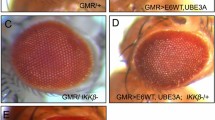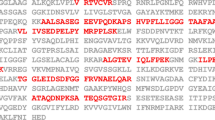Abstract
The E5 protein of human papillomavirus type 16 (HPV16) is a small hydrophobic protein, which localizes to the cell membrane, Golgi apparatus and endosomes. HPV16 E5 enhances the activation of the epidermal growth factor (EGFR). The activated EGFR is downregulated through the endocytic pathway, where E5 has been shown to inhibit endosomal acidification and trafficking. Ubiquitination of the activated EGFR plays a role in this downregulation. c-Cbl is a ubiquitin ligase that associates with the activated EGFR and targets it for degradation. Since E5 has been shown to form a complex with the EGFR, we tested the hypothesis that E5 affects the interaction of c-Cbl with the EGFR. We found a significant decrease of c-Cbl bound to the EGFR and of ubiquitinated EGFR in the presence of E5. E5 did not affect c-Cbl steady-state level, phosphorylation or translocation to the membrane. This novel result suggests that HPV16 E5 may, at least in part, upregulate EGFR-mediated signal transduction by inhibiting the interaction of c-Cbl with the EGFR, thereby decreasing c-Cbl-mediated degradation of the EGFR.
This is a preview of subscription content, access via your institution
Access options
Subscribe to this journal
Receive 50 print issues and online access
$259.00 per year
only $5.18 per issue
Buy this article
- Purchase on Springer Link
- Instant access to full article PDF
Prices may be subject to local taxes which are calculated during checkout



Similar content being viewed by others
References
Akerman GS, Tolleson WH, Brown KL, Zyzak LL, Mourateva E, Engin TS, Basaraba A, Coker AL, Creek KE and Pirisi L . (2001). Cancer Res., 61, 3837–3843.
Alwan HA, van Zoelen EJ and van Leeuwen JE . (2003). J. Biol. Chem., 278, 35781–35790.
Boni-Schnetzler M and Pilch PF . (1987). Proc. Natl. Acad. Sci. USA, 84, 7832–7836.
Bouvard V, Matlashewski G, Gu ZM, Storey A and Banks L . (1994). Virology, 203, 73–80.
Bowtell DD and Langdon WY . (1995). Oncogene, 11, 1561–1567.
Burke P, Schooler K and Wiley HS . (2001). Mol. Cell. Biol., 12, 1897–1910.
Conrad M, Bubb VJ and Schlegel R . (1993). J. Virol., 67, 6170–6178.
Crusius K, Auvinen E, Steuer B, Gaissert H and Alonso A . (1998). Exp. Cell Res., 241, 76–83.
de Melker AA, van der Horst G, Calafat J, Jansen H and Borst J . (2001). J. Cell Sci., 114, 2167–2178.
Di Fiore PP and Gill GN . (1999). Curr. Opin. Cell Biol., 11, 483–488.
DiMaio D and Mattoon D . (2001). Oncogene, 20, 7866–7873.
Fukazawa T, Miyake S, Band V and Band H . (1996). J. Biol. Chem., 271, 14554–14559.
Genther SM, Sterling S, Duensing S, Munger K, Sattler C and Lambert PF . (2003). J. Virol., 77, 2832–2842.
Gonzalez SL, Stremlau M, He X, Basile JR and Munger K . (2001). J. Virol., 75, 7583–7591.
Grant S, Qiao L and Dent P . (2002). Front. Biosci., 7, d376–d389.
Gu Z and Matlashewski G . (1995). J. Virol., 69, 8051–8056.
Holbro T, Civenni G and Hynes NE . (2003). Exp. Cell Res., 284, 99–110.
Hubbard SR . (1999). Prog. Biophys. Mol. Biol., 71, 343–358.
Hwang ES, Nottoli T and Dimaio D . (1995). Virology, 211, 227–233.
Joazeiro CA, Wing SS, Huang H, Leverson JD, Hunter T and Liu YC . (1999). Science, 286, 309–312.
Kersemaekers AM, Fleuren GJ, Kenter GG, Van den Broek LJ, Uljee SM, Hermans J and van de Vijver MJ . (1999). Clin. Cancer Res., 5, 577–586.
Leechanachai P, Banks L, Moreau F and Matlashewski G . (1992). Oncogene, 7, 19–25.
Levkowitz G, Klapper LN, Tzahar E, Freywald A, Sela M and Yarden Y . (1996). Oncogene, 12, 1117–1125.
Levkowitz G, Waterman H, Zamir E, Kam Z, Oved S, Langdon WY, Beguinot L, Geiger B and Yarden Y . (1998). Genes Dev., 12, 3663–3674.
Longva KE, Blystad FD, Stang E, Larsen AM, Johannessen LE and Madshus IH . (2002). J. Cell Biol., 156, 843–854.
Mantovani F and Banks L . (1999). Semin. Cancer Biol., 9, 387–395.
Mathur SP, Mathur RS, Rust PF and Young RC . (2001). Am. J. Reprod. Immunol., 46, 280–287.
Munger K, Basile JR, Duensing S, Eichten A, Gonzalez SL, Grace M and Zacny VL . (2001). Oncogene, 20, 7888–7898.
Munger K, Scheffner M, Huibregtse JM and Howley PM . (1992). Cancer Surv., 12, 197–217.
Pim D, Collins M and Banks L . (1992). Oncogene, 7, 27–32.
Potter DA, Tirnauer JS, Janssen R, Croall DE, Hughes CN, Fiacco KA, Mier JW, Maki M and Herman IM . (1998). J. Cell Biol., 141, 647–662.
Ravid T, Heidinger JM, Gee P, Khan EM and Goldkorn T . (2004). J. Biol. Chem., 279, 37153–37162.
Scheffner M, Werness BA, Huibregtse JM, Levine AJ and Howley PM . (1990). Cell, 63, 1129–1136.
Sedman SA, Barbosa MS, Vass WC, Hubbert NL, Haas JA, Lowy DR and Schiller JT . (1991). J. Virol., 65, 4860–4866.
Sorkin A, Waters C, Overholser KA and Carpenter G . (1991). J. Biol. Chem., 266, 8355–8362.
Stoppler MC, Straight SW, Tsao G, Schlegel R and McCance DJ . (1996). Virology, 223, 251–254.
Straight SW, Herman B and McCance DJ . (1995). J. Virol., 69, 3185–3192.
Straight SW, Hinkle PM, Jewers RJ and McCance DJ . (1993). J. Virol., 67, 4521–4532.
Thien CBF and Langdon WY . (2001). Nat. Rev. Mol. Cell. Biol., 2, 294–305.
Thomas M, Pim D and Banks L . (1999). Oncogene, 18, 7690–7700.
Thomsen P, van Deurs B, Norrild B and Kayser L . (2000). Oncogene, 19, 6023–6032.
Valle GF and Banks L . (1995). J. Gen. Virol., 76, 1239–1245.
Yokouchi M, Kondo T, Houghton A, Bartkiewicz M, Horne WC, Zhang H, Yoshimura A and Baron R . (1999). J. Biol. Chem., 274, 31707–31712.
Zhang B, Spandau DF and Roman A . (2002). J. Virol., 76, 220–231.
zur Hausen H . (1996). Biochim. Biophys. Acta, 1288, F55–F78.
zur Hausen H . (1999). Semin. Cancer Biol., 9, 405–411.
Acknowledgements
The research was supported in part by a grant from the Lilly Center for Women's Health (AR), INGEN (AR), the Thoracic Oncology Program, Indiana University (DP), a Clarian Values Foundation grant (DP) and NIH Grant 1P20-GM66402 (DP). The Indiana Genomics Initiative (INGEN) of Indiana University is supported in part by Lilly Endowment Inc. We thank Mae Lewis and Wei Chen for technical assistance and Denise Galloway for providing the L(16E5)SN packaging cell line.
Author information
Authors and Affiliations
Corresponding author
Rights and permissions
About this article
Cite this article
Zhang, B., Srirangam, A., Potter, D. et al. HPV16 E5 protein disrupts the c-Cbl–EGFR interaction and EGFR ubiquitination in human foreskin keratinocytes. Oncogene 24, 2585–2588 (2005). https://doi.org/10.1038/sj.onc.1208453
Received:
Accepted:
Published:
Issue Date:
DOI: https://doi.org/10.1038/sj.onc.1208453
Keywords
This article is cited by
-
Virus against virus: strategies for using adenovirus vectors in the treatment of HPV-induced cervical cancer
Acta Pharmacologica Sinica (2021)
-
E6-mediated activation of JNK drives EGFR signalling to promote proliferation and viral oncoprotein expression in cervical cancer
Cell Death & Differentiation (2021)
-
The deubiquitinase (DUB) USP13 promotes Mcl-1 stabilisation in cervical cancer
Oncogene (2021)
-
hrHPV E5 oncoprotein: immune evasion and related immunotherapies
Journal of Experimental & Clinical Cancer Research (2017)
-
Mutation analysis of EGFR and its correlation with the HPV in Indian cervical cancer patients
Tumor Biology (2016)



